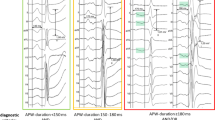Abstract
Background
Atrial fibrillation (AF) increases morbidity and mortality in heart failure with preserved ejection fraction (HFpEF), yet identification of HFpEF-patients at risk for new-onset AF is challenging. Amplified P-wave duration (APWD) non-invasively detects arrhythmogenic atrial substrate with high accuracy. We hypothesized that APWD may help in the prediction of new-onset AF in HFpEF.
Methods
Patients with suspected HFpEF (n = 99, left ventricular ejection fraction > 50%, no evidence of valvulopathy, coronary artery disease, or non-cardiac dyspnea) underwent exercise testing with concomitant right-heart catheterization. Normal resting pulmonary capillary wedge pressure (PCWP; < 12 mmHg) with an increase during exercise > 25.5 mmHg/W/kg defined early HFpEF. Advanced HFpEF was diagnosed with PCWP > 12 mmHg at rest. Arrhythmogenic atrial substrate (defined as APWD > 150 ms) was investigated on digitized standard 12-lead ECGs and patients were followed for new-onset AF at 6-month intervals.
Results
Forty-seven patients had normal exercise haemodynamics and served as controls. Early and advanced HFpEF was diagnosed in 29 and 23 patients, respectively. Eighty-seven per cent of patients with advanced HFpEF had evidence of arrhythmogenic atrial substrate, (APWD 175 ± 29 ms vs. 132 ± 14 ms in controls, p < 0.0001), which was associated with a tenfold increased risk for new-onset AF during 4.6 years of follow-up (hazard ratio [HR] 9.684, 95% CI 2.61–35.89, p < 0.0001). Early HFpEF was neither related to APWD (p = 0.395), nor to a higher risk for AF (HR 3.44, 95% CI 0.57–20.72, p = 0.178). Importantly, the presence of arrhythmogenic substrate was independent of left atrial indexed volume.
Conclusion
The analysis of amplified P-wave duration (APWD) allows for the prediction of new-onset AF in patients with advanced HFpEF.





Similar content being viewed by others
References
Zakeri R, Chamberlain AM, Roger VL, Redfield MM (2013) Temporal relationship and prognostic significance of atrial fibrillation in heart failure patients with preserved ejection fraction: a community-based study. Circulation 128(10):1085–1093
Santhanakrishnan R, Wang N, Larson MG, Magnani JW, McManus DD, Lubitz SA et al (2016) Atrial fibrillation begets heart failure and vice versa: temporal associations and differences in preserved versus reduced ejection fraction. Circulation 133(5):484–492
Jobs A, Schwind J, Katalinic A, Babaev V, Tilz RR, Rausch S et al (2019) Prognostic significance of atrial fibrillation in acute decompensated heart failure with reduced versus preserved ejection fraction. Clin Res Cardiol 108(1):74–82
Tschöpe C, Birner C, Böhm M, Bruder O, Frantz S, Luchner A et al (2018) Heart failure with preserved ejection fraction: current management and future strategies: expert opinion on the behalf of the Nucleus of the Heart Failure Working Group of the German Society of Cardiology (DKG). Clin Res Cardiol 107(1):1–19
Lam CSP, Rienstra M, Tay WT, Liu LCY, Hummel YM, van der Meer P et al (2017) Atrial fibrillation in heart failure with preserved ejection fraction: association with exercise capacity, left ventricular filling pressures, natriuretic peptides, and left atrial volume. JACC Hear Fail 5(2):92–98
Santema BT, Chan MMY, Tromp J, Dokter M, van der Wal HH, Emmens JE et al (2019) The influence of atrial fibrillation on the levels of NT-proBNP versus GDF-15 in patients with heart failure. Clin Res Cardiol 1:1–8
Sanders P, Morton JB, Davidson NC, Spence SJ, Vohra JK, Sparks PB et al (2003) Electrical remodeling of the atria in congestive heart failure: electrophysiological and electroanatomic mapping in humans. Circulation 108(12):1461–1468
Jadidi A, Müller-Edenborn B, Chen J, Keyl C, Weber R, Allgeier J et al (2018) The duration of the amplified sinus-P wave identifies presence of left atrial low voltage substrate and predicts outcome after pulmonary vein isolation in patients with persistent atrial fibrillation. JACC Clin Electrophysiol 4(4):531–543
Dorfs S, Zeh W, Hochholzer W, Jander N, Kienzle R-P, Pieske B et al (2014) Pulmonary capillary wedge pressure during exercise and long-term mortality in patients with suspected heart failure with preserved ejection fraction. Eur Hear J 44(35):3103–3112
Maeder MT, Thompson BR, Brunner-La Rocca HP, Kaye DM (2010) Hemodynamic basis of exercise limitation in patients with heart failure and normal ejection fraction. J Am Coll Cardiol 56(11):855–863
Evangelista A, Flachskampf F, Lancellotti P, Badano L, Aguilar R, Monaghan M et al (2008) European Association of Echocardiography recommendations for standardization of performance, digital storage and reporting of echocardiographic studies. Eur J Echocardiogr 9(4):438–448
Linssen GCM, Rienstra M, Jaarsma T, Voors AA, Van Gelder IC, Hillege HL et al (2011) Clinical and prognostic effects of atrial fibrillation in heart failure patients with reduced and preserved left ventricular ejection fraction. Eur J Heart Fail 13(10):1111–1120
Ahmed A, Thornton P, Perry GJ, Allman RM, Delong JF (2004) Impact of atrial fibrillation on mortality and readmission in older adults hospitalized with heart failure. Eur J Heart Fail 6(4):421–426
Rivero-Ayerza M, Scholte Op Reimer W, Lenzen M, Theuns DAMJ, Jordaens L, Komajda M et al (2008) New-onset atrial fibrillation is an independent predictor of in-hospital mortality in hospitalized heart failure patients: results of the EuroHeart Failure Survey. Eur Heart J 29(13):1618–1624
Park J, Joung B, Uhm JS, Shim CY, Hwang C, Hyoung Lee M et al (2014) High left atrial pressures are associated with advanced electroanatomical remodeling of left atrium and independent predictors for clinical recurrence of atrial fibrillation after catheter ablation. Hear Rhythm 11(6):953–960
Sramko M, Wichterle D, Melenovsky V, Clemens M, Fukunaga M, Peichl P et al (2017) Resting and exercise-induced left atrial hypertension in patients with atrial fibrillation. JACC Clin Electrophysiol 3(5):461–469
Geske JB, Sorajja P, Nishimura RA, Ommen SR (2007) Evaluation of left ventricular filling pressures by doppler echocardiography in patients with hypertrophic cardiomyopathy. Circulation [Internet] 116(23):2702–2708
Author information
Authors and Affiliations
Corresponding author
Ethics declarations
Conflict of interest
The authors declare no conflict of interest.
Rights and permissions
About this article
Cite this article
Müller-Edenborn, B., Minners, J., Kocher, S. et al. Amplified P-wave duration predicts new-onset atrial fibrillation in patients with heart failure with preserved ejection fraction. Clin Res Cardiol 109, 978–987 (2020). https://doi.org/10.1007/s00392-019-01590-z
Received:
Accepted:
Published:
Issue Date:
DOI: https://doi.org/10.1007/s00392-019-01590-z




